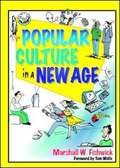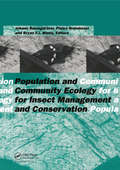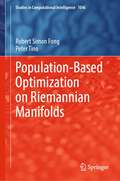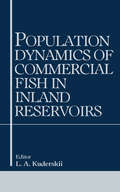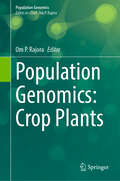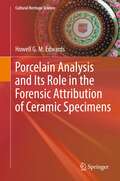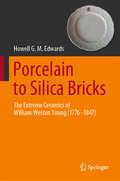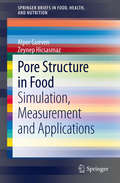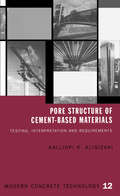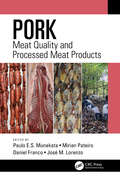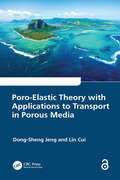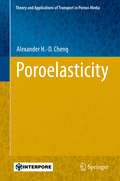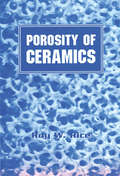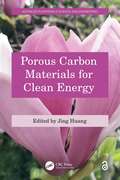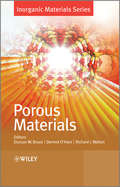- Table View
- List View
Popular Culture in a New Age
by Marshall William FishwickFishwick (interdisciplinary studies, American studies, and popular culture studies, Virginia Tech) offers observations on popular culture in view of the changes brought about by the information revolution and the digital divide. Coverage hops about to address issues such as the millennium; distinctions between folk, fake, and pop; sacred symbols; the cult of celebrity; war; postmodern pop; and the concept of the global village, among other topics. Includes a couple of contributions by graduate students with similar snappy, stream-of-consciousness approaches.
Popular Mechanics The Big Little Book of Awesome Stuff: 300 Wild Facts, Fun Projects and Amazing Tricks
by Dan BovaDevelop new skills (card tricks!), make fun things (a water balloon launcher!) and learn crazy-cool facts with this hands-on activity book for ages 8 to 12Do you want to find out weird-but-true facts like how to safely enter a black hole or what to do if you meet a mythological monster? Interested in hitting a dizzying ping-pong trick shot or performing mind-blowing magic that&’ll amaze your friends? Think it&’d be fun to make the ultimate paper airplane or an insane water balloon launcher? If you answered yes to any of these questions, you&’ve come to the right book! The editors of Popular Mechanics put together this incredible, super-cool collection of did-you-know facts, super-fun projects and astounding skills for curious kids who like to discover stuff, build things, goof around a lot — and sometimes make a big mess in the process. (Don&’t tell your parents that last part!) On these totally non-boring pages you&’ll discover:Weird facts about pets…like the wild thing that happens when a dog shakes itself dry! The most incredible things ever built…like a 50-foot tall robot!Hilarious tricks and pranks to pull on your friends…if you dare! How to have a million-dollar idea and how to get on Jeopardy! Pro secrets for throwing a curveball and shooting a 3-pointer! How to contact aliens! Plus, even more awesome stuff! (More awesome than talking to aliens? Really? Yes, really!) Are you ready? Pick up this book and let the adventures begin!
Population and Community Ecology for Insect Management and Conservation
by Johann Baumgärtner Pietro Brandmayr Bryan Rj. ManlyOne of the themes of the 20th International Congress of Entomology held in Florence in August 1996 was Ecology and Population Dynamics, with papers presented on single species dynamics, population interactions, and community ecology. This book contains a selection of the papers that were presented, and gives a late-1990s picture of the latest research in this fast developing area.
Population-Based Optimization on Riemannian Manifolds (Studies in Computational Intelligence #1046)
by Robert Simon Fong Peter TinoManifold optimization is an emerging field of contemporary optimization that constructs efficient and robust algorithms by exploiting the specific geometrical structure of the search space. In our case the search space takes the form of a manifold. Manifold optimization methods mainly focus on adapting existing optimization methods from the usual “easy-to-deal-with” Euclidean search spaces to manifolds whose local geometry can be defined e.g. by a Riemannian structure. In this way the form of the adapted algorithms can stay unchanged. However, to accommodate the adaptation process, assumptions on the search space manifold often have to be made. In addition, the computations and estimations are confined by the local geometry.This book presents a framework for population-based optimization on Riemannian manifolds that overcomes both the constraints of locality and additional assumptions. Multi-modal, black-box manifold optimization problems on Riemannian manifolds can be tackled using zero-order stochastic optimization methods from a geometrical perspective, utilizing both the statistical geometry of the decision space and Riemannian geometry of the search space.This monograph presents in a self-contained manner both theoretical and empirical aspects of stochastic population-based optimization on abstract Riemannian manifolds.
Population Dynamics of Commercial Fish in Inland Reservoirs
by L.A. KuderskiiThis text analyzes the structure of fish populations in inland reservoirs, based on absolute values of their mass. The structure of population and its changes have been examined in seven fish species from small lakes, two from large lakes and seven from large reservoirs in plains. Special attention has been paid to the main indicator of the structure of population-correlation between the age of ichthyomass and mass maturation.
Population Genomics: Crop Plants (Population Genomics)
by Om P. RajoraPopulation genomics has revolutionized several disciplines of biology, genetic resource conservation and management, and breeding of crop plants by providing key and novel insights into population, evolutionary, ecological and conservation genetics, ecology, evolution and adaptation, and facilitating molecular breeding with an unprecedented power and accuracy. Crop plants have been domesticated from their wild progenitors over several centuries and have undergone severe genetic bottlenecks and selection sweeps. Population genomics research has unraveled novel insights into crop plants origin, evolution, demographic history, center of diversity, domestication history, genetic/genomic diversity and genetic structure of wild and domesticated populations and species, epigenomic diversity, genetic/genomic basis of domestication syndrome, genomic footprints of domestication, selection and breeding, de-domestication, speciation and admixture, taxonomy, phylogeny, ecology, biotic and abiotic stress tolerance, and ecological and climate adaptation. Population genomics has also facilitated the development of pangenomes, conservation and management of genetic diversity including in the pre-breeding and breeding programs, and genomics-assisted breeding via identifying genotype-phenotype associations and genomic selection in crop plants. This pioneering book presents the advances made and potential of population genomics in addressing the above crop plants aspects of basic and applied significance and brings together leading experts in crop plants population genomics to discuss these topics in major crop plants. Genomic, epigenomic, transcriptomic and plant resources available for population genomics research and challenges, opportunities and future perspectives of crop plants population genomics are also discussed. Chapters "Population Genomics of Yams: Evolution and Domestication of Dioscorea Species" and "Population Genomics Along With Quantitative Genetics Provides a More Efficient Valorization of Crop Plant Genetic Diversity in Breeding and Pre-breeding Programs" are available open access under a Creative Commons Attribution 4.0 International License via link.springer.com.
Population-Level Ecological Risk Assessment
by Lawrence W. Barnthouse Wayne R. Munns Jr. Mary T. SorensenMost ecological risk assessments consider the risk to individual organisms or organism-level attributes. From a management perspective, however, risks to population-level attributes and processes are often more relevant. Despite many published calls for population risk assessment and the abundance of available scientific research and technical tool
Populism, Media and Education: Challenging discrimination in contemporary digital societies (Routledge Research in Education)
by Maria RanieriBased on a major research project funded by the European Commission, Populism, Media and Education studies how discriminatory stereotypes are built online with a particular focus on right-wing populism. Globalization and migration have led to a new era of populism and racism in Western countries, rekindling traditional forms of discrimination through innovative means. New media platforms are being seen by populist organizations as a method to promote hate speech and unprecedented forms of proselytism. Race, gender, disability and sexual orientation are all being used to discriminate and young people are the preferred target for populist organizations and movements. This book examines how media education can help to deconstruct such hate speech and promote young people’s full participation in media-saturated societies. Drawing on rich examples from Austria, Belgium, Bulgaria, France, Italy, Slovenia, and the UK - countries characterized by different political and cultural contexts – Populism, Media and Education addresses key questions about the meaning of new populism, the nature of e-engagement, and the role of education and citizenship in the digital century. With its international and interdisciplinary approach, this book is essential reading for academics and students in the areas of education, media studies, sociology, cultural studies, political sciences, discrimination and gender studies.
Porcelain Analysis and Its Role in the Forensic Attribution of Ceramic Specimens (Cultural Heritage Science)
by Howell G. EdwardsThe material for this book arose from the author’s research into porcelains over many years, as a collector in appreciation of their artistic beauty , as an analytical chemist in the scientific interrogation of their body paste, enamel pigments and glaze compositions, and as a ceramic historian in the assessment of their manufactory foundations and their correlation with available documentation relating to their recipes and formulations. A discussion of the role of analysis in the framework of a holistic assessment of artworks and specifically the composition of porcelain, namely hard paste, soft paste, phosphatic, bone china and magnesian, is followed by its growth from its beginnings in China to its importation into Europe in the 16th Century. A survey of European porcelain manufactories in the 17th and 18th Centuries is followed by a description of the raw materials, minerals and recipes for porcelain manufacture and details of the chemistry of the high temperature firing processes involved therein. The historical backgrounds to several important European factories are considered, highlighting the imperfections in the written record that have been perpetuated through the ages. The analytical chemical information derived from the interrogation of specimens, from fragments, shards or perfect finished items, is reviewed and operational protocols established for the identification of a factory output from the data presented. Several case studies are examined in detail across several porcelain manufactories to indicate the role adopted by modern analytical science, with information provided at the quantitative elemental oxide and qualitative molecular spectroscopic levels, where applicable. The attribution of a specimen to a particular factory is either supported thereby or in some cases a potential reassessment of an earlier attribution is indicated. Overall, the information provided by analytical chemical data is seen to be extremely useful for porcelain identification and for its potential attribution in the context of a holistic forensic evaluation of hitherto unknown porcelain exemplars of questionable factory origins.
Porcelain to Silica Bricks: The Extreme Ceramics of William Weston Young (1776-1847)
by Howell G.M. EdwardsThe title of this book describes the two extremes of ceramic invention from aesthetically beautiful and decorative works of art that graced the tables of the aristocracy to the functional silica brick that lined the smelting furnaces of industrialised nations in the 19th century designed to produce iron, copper and glass. Both of these ceramics are linked to one man, William Weston Young (1776-1847) and with his contemporaries both of these ceramic extremes became world leaders in their own right. The book traces the history of Young and his ambitions, his interactions with numerous associates and the influence these ceramics attained in 19th century society. The book provides a sequel to the two preceding texts on Nantgarw and Swansea porcelains (also published by Springer), which cover one extreme and extends the discourse onto the other extreme, which until now has been relatively ignored despite its scientific and engineering importance. The trilogy has now therefore been completed. This book examines the historical documentation along with scientific analytical data from the last 100 years up to the present in a novel holistic forensic approach.It will be of interest to porcelain collectors, ceramics analysts, museum ceramic curators, ceramic historians, analytical scientists, cultural heritage preservation, industrial archaeologists and industrial museums.
Pore Structure in Food: Simulation, Measurement and Applications
by Zeynep Hicsasmaz Alper GuevenThe pore structure of foods directly affects the success of such food processes as drying, puffing, freeze-drying, and rehydration. Consequently, the pore structure of foods determines what types of food processes will work best with a particular food. This Brief will first discuss in depth the need to correctly measure the pore structure of foods and then will identify and describe in detail the current methods available to measure food porosity. Finally, it will review the applications of these various methods.
Pore Structure of Cement-Based Materials: Testing, Interpretation and Requirements (Modern Concrete Technology)
by Kalliopi K. AligizakiPore Structure of Cement-Based Materials provides a thorough treatment of the experimental techniques used to characterize the pore structure of materials. The text presents the principles and practical applications of the techniques used, organized in an easy-to-follow and uncomplicated manner, providing the theoretical background, the way to anal
Pork: Meat Quality and Processed Meat Products
by Paulo E. S. MunekataThe processing of pork is a common technological practice that modifies the taste, flavor, texture and color of raw pork meat. Due to pork’s accessible price and versatility, the manufacture of pork products to offer a variety of options to consumers is an important strategy of the meat industries in this sector to improve profits and expand into new markets at the local, regional and international levels. The diversity of pork products reflects the diversity and history of many local cultures around the world, as well as a growing interest in preserving traditional processing practices. Pork: Meat Quality and Processed Meat Products delves into the various kinds of pork and the methods used to prepare it for consumption, including fresh meat products, fermented sausages, dry-cured products, blood sausages and cooked sausages. Each category starts with a specific raw material (entire cut vs. minced pork meat) to which is added a unique combination of ingredients (e.g., sodium chloride, starter cultures, blood, seasoning and spices). The method of processing (such as salting, drying, thermal processing and fermenting) takes consumer tastes and storage needs into account, as well as how each product will be consumed (cooked, sliced, spread and as an ingredient in other dishes, for instance). Consequently, a wide range of products made from pork are currently being produced worldwide. Added to this is the increasing importance of ingredients and health factors to consumers; the resulting demand for products that address specific health concerns is having a significant impact on research into and the production of pork meat products. Key Features: Comprehensively presents and discusses the wealth of information about pork products Includes specific details about the processing, quality of final products and innovation in the industry Presents innovative, health-oriented approaches to making traditional and commercial pork products Discusses healthier pork meat products that address consumer trends and government recommendations The production of health-oriented pork products is an emerging and promising investigation area with a direct impact on the currect market for meat products.
Poro-Elastic Theory with Applications to Transport in Porous Media
by Dong-Sheng Jeng Lin CuiThis book treats the subject of porous flow and its applications in three engineering and scientific problems. The first major part of the book is devoted to solute transport in unsaturated porous media. Dynamic hydraulic conductivity and degree of saturation associate with pore pressures are also included in the consolidation-induced solute transport process. The second part of this book focuses on tidal dynamics in coastal aquifers, including shallow water expansion for sloping beaches, two-dimensional problem in estuarine zone and leaky confined aquifers. The final part of the book summarizes the recent development of porous model in the field of liquefaction around marine infrastructures including fundamental mechanisms of momentary and residual seabed liquefaction, two-dimensional and three-dimensional porous models for fluid-seabed interactions around breakwaters, pipelines and piled foundations in marine environments. The authors’ aim is to describe in detail the applications of porous models for several engineering problems. This book will provide academic researchers and industry an overview of recent development in the field of porous models and the applications. The Open Access version of this book, available at http://www.taylorfrancis.com, has been made available under a Creative Commons Non Commercial-No Derivatives (CC-BY-NC-ND) 4.0 license. Funded by Qingdao University Technology, China
Poroelasticity
by Alexander H.-D. ChengThis book treats the mechanics of porous materials infiltrated with a fluid (poromechanics), focussing on its linear theory (poroelasticity). Porous materials from inanimate bodies such as sand, soil and rock, living bodies such as plant tissue, animal flesh, or man-made materials can look very different due to their different origins, but as readers will see, the underlying physical principles governing their mechanical behaviors can be the same, making this work relevant not only to engineers but also to scientists across other scientific disciplines. Readers will find discussions of physical phenomena including soil consolidation, land subsidence, slope stability, borehole failure, hydraulic fracturing, water wave and seabed interaction, earthquake aftershock, fluid injection induced seismicity and heat induced pore pressure spalling as well as discussions of seismoelectric and seismoelectromagnetic effects. The work also explores the biomechanics of cartilage, bone and blood vessels. Chapters present theory using an intuitive, phenomenological approach at the bulk continuum level, and a thermodynamics-based variational energy approach at the micromechanical level. The physical mechanisms covered extend from the quasi-static theory of poroelasticity to poroelastodynamics, poroviscoelasticity, porothermoelasticity, and porochemoelasticity. Closed form analytical solutions are derived in details. This book provides an excellent introduction to linear poroelasticity and is especially relevant to those involved in civil engineering, petroleum and reservoir engineering, rock mechanics, hydrology, geophysics, and biomechanics.
Poromechanics: Proceedings of the 1st Biot conference
by J. F. ThimusThis text features 105 papers dealing with the fundamentals and the applications of poromechanics from the Biot conference of 1998, held in Louvain-la-Neuve. Topics include: wave propogation; numerical modelling; identification of poromechanical parameters; and constitutive modelling.
Poromechanics II: Proceedings of the Second Biot Conference on Poromechanics, Grenoble, France, 26-28 August 2002
by J.-L. Auriault, C. Geindreau, P. Royer, J.-F. Bloch, C. Boutin and J. LewandowskaThese proceedings deal with the fundamentals and applications of poromechanics to geomechanics, material sciences, geophysics, acoustics and biomechanics. They discuss the state of the art in such topics as constitutive modelling and upscaling methods.
Porosity of Ceramics: Properties and Applications (Materials Engineering #12)
by Roy W. RiceFocuses on the effects of porosity and microcracking on the physical properties of ceramics, particularly nominally single phase ceramics. The book elucidates the fundamental interrelationships determining the development and use of materials for actual and potential engineering needs. It aims to help in the understanding of porosity effects on other materials, from ceramic composties, cements and plasters to rocks, metals and polymers. College or university bookshops may order five or more copies at a special student price, available on request.
Porous Carbon Materials for Clean Energy (ISSN)
by Jing HuangPorous carbons are widely used as electrode materials for supercapacitors owing to their high specific surface areas, abundant surface functionalities, well‑controlled pore systems, and excellent conductivity and stability. New carbon materials with well‑defined nanostructures and functionalization patterns have been developed to meet challenges of a growing global demand for energy‑saving materials and sustainable materials to reduce negative environmental consequences. This book describes progress toward the conversion and efficient utilization of porous carbon and its derived precursor as electrode materials for clean energy.• Explores the chemical structure, composition, properties, classification, and application of various porous carbon nanoparticles and nanostructured materials for clean energy uses• Proposes strategies for porous carbon production through featured examples• Covers a variety of materials, including those derived from biomass, graphene, aerogels, and carbon nanofibers• Discusses applications including electrocatalysts, batteries, hydrogen production, supercapacitors, and energy storage• Examines challenges and future opportunitiesThis book will be of interest to materials and chemical engineers, scientists, researchers, and others active in advancing the development of renewable and clean energy technologies.
Porous Carbons - Hyperbranched Polymers - Polymer Solvation
by Timothy E. Long Brigitte Voit Oguz OkayThe series Advances in Polymer Science presents critical reviews of the present and future trends in polymer and biopolymer science. It covers all areas of research in polymer and biopolymer science including chemistry, physical chemistry, physics, material science. The thematic volumes are addressed to scientists, whether at universities or in industry, who wish to keep abreast of the important advances in the covered topics. Advances in Polymer Science enjoy a longstanding tradition and good reputation in its community. Each volume is dedicated to a current topic, and each review critically surveys one aspect of that topic, to place it within the context of the volume. The volumes typically summarize the significant developments of the last 5 to 10 years and discuss them critically, presenting selected examples, explaining and illustrating the important principles, and bringing together many important references of primary literature. On that basis, future research directions in the area can be discussed. Advances in Polymer Science volumes thus are important references for every polymer scientist, as well as for other scientists interested in polymer science - as an introduction to a neighboring field, or as a compilation of detailed information for the specialist. Review articles for the individual volumes are invited by the volume editors. Single contributions can be specially commissioned. Readership: Polymer scientists, or scientists in related fields interested in polymer and biopolymer science, at universities or in industry, graduate students.
Porous Materials
by Duncan W. Bruce Dermot O'Hare Richard I. WaltonIn the past few decades, the increasingly routine use of advanced structural probes for studying the structure and dynamics of the solid state has led to some dramatic developments in the field of porous solids. These materials are fundamental in a diverse range of applications, such as shape-selective catalysts for energy-efficient organic transformations, new media for pollutant removal, and gas storage materials for energy technologies. Porosity in inorganic materials may range from the nano-scale to the macro-scale, and the drive towards particular properties remains the goal in this fast-developing area of research. Covering some of the key families of inorganic solids that are currently being studied, Porous Materials discusses: Metal Organic Frameworks MaterialsMesoporous SilicatesOrdered Porous Crystalline Transition Metal OxidesRecent Developments in Templated Porous Carbon MaterialsSynthetic Silicate Zeolites: Diverse Materials Accessible Through GeoinspirationAdditional volumes in the Inorganic Materials Series:Low-Dimensional Solids | Molecular Materials | Functional Oxides | Energy Materials
Porous Materials: Theory and Its Application for Environmental Remediation (Engineering Materials)
by Juan Carlos Moreno-Piraján Liliana Giraldo-Gutierrez Fernando Gómez-GranadosThis book is written in honor of Prof. Francisco Rodriguez-Reinoso, who has made significant contributions in the area of porous materials such as active carbons and graphenes. It details the preparation of porous materials, including carbonaceous, zeolitic, and siliceous materials, MOFs, aerogels, and xerogels, describing the characterization techniques and the interpretation of the results, and highlighting common errors that can occur during the process. This book subsequently presents the use of modeling based on thermodynamics to describe the materials. Lastly, it illustrates a number of current environmental protection applications in the context of both water and air.
Porous Materials for Carbon Dioxide Capture
by An-Hui Lu Sheng DaiThis multi-authored book provides a comprehensive overview of the latest developments in porous CO2 capture materials, including ionic liquid-derived carbonaceous adsorbents, porous carbons, metal-organic frameworks, porous aromatic frameworks, micro porous organic polymers. It also reviews the sorption techniques such as cyclic uptake and desorption reactions and membrane separations. In each category, the design and fabrication, the comprehensive characterization, the evaluation of CO2 sorption/separation and the sorption/degradation mechanism are highlighted. In addition, the advantages and remaining challenges as well as future perspectives for each porous material are covered. This book is aimed at scientists and graduate students in such fields as separation, carbon, polymer, chemistry, material science and technology, who will use and appreciate this information source in their research. Other specialists may consult specific chapters to find the latest, authoritative reviews. Dr. An-Hui Lu is a Professor at the State Key Laboratory of Fine Chemicals, School of Chemical Engineering, Faculty of Chemical, Environmental and Biological Science and Technology, Dalian University of Technology, China. Dr. Sheng Dai is a Corporate Fellow and Group Leader in the Chemical Sciences Division at Oak Ridge National Laboratory (ORNL) and a Professor of Chemistry at the University of Tennessee, USA.
Porous Media: Applications in Biological Systems and Biotechnology
by Kambiz VafaiPresenting state-of-the-art research advancements, Porous Media: Applications in Biological Systems and Biotechnology explores innovative approaches to effectively apply existing porous media technologies to biomedical applications. In each peer-reviewed chapter, world-class scientists and engineers collaborate to address significant problems and d
Porous Media Transport Phenomena
by Faruk CivanThe book that makes transport in porous media accessible to students and researchers alikePorous Media Transport Phenomena covers the general theories behind flow and transport in porous media-a solid permeated by a network of pores filled with fluid-which encompasses rocks, biological tissues, ceramics, and much more. Designed for use in graduate courses in various disciplines involving fluids in porous materials, and as a reference for practitioners in the field, the text includes exercises and practical applications while avoiding the complex math found in other books, allowing the reader to focus on the central elements of the topic.Covering general porous media applications, including the effects of temperature and particle migration, and placing an emphasis on energy resource development, the book provides an overview of mass, momentum, and energy conservation equations, and their applications in engineered and natural porous media for general applications. Offering a multidisciplinary approach to transport in porous media, material is presented in a uniform format with consistent SI units.An indispensable resource on an extremely wide and varied topic drawn from numerous engineering fields, Porous Media Transport Phenomena includes a solutions manual for all exercises found in the book, additional questions for study purposes, and PowerPoint slides that follow the order of the text.
